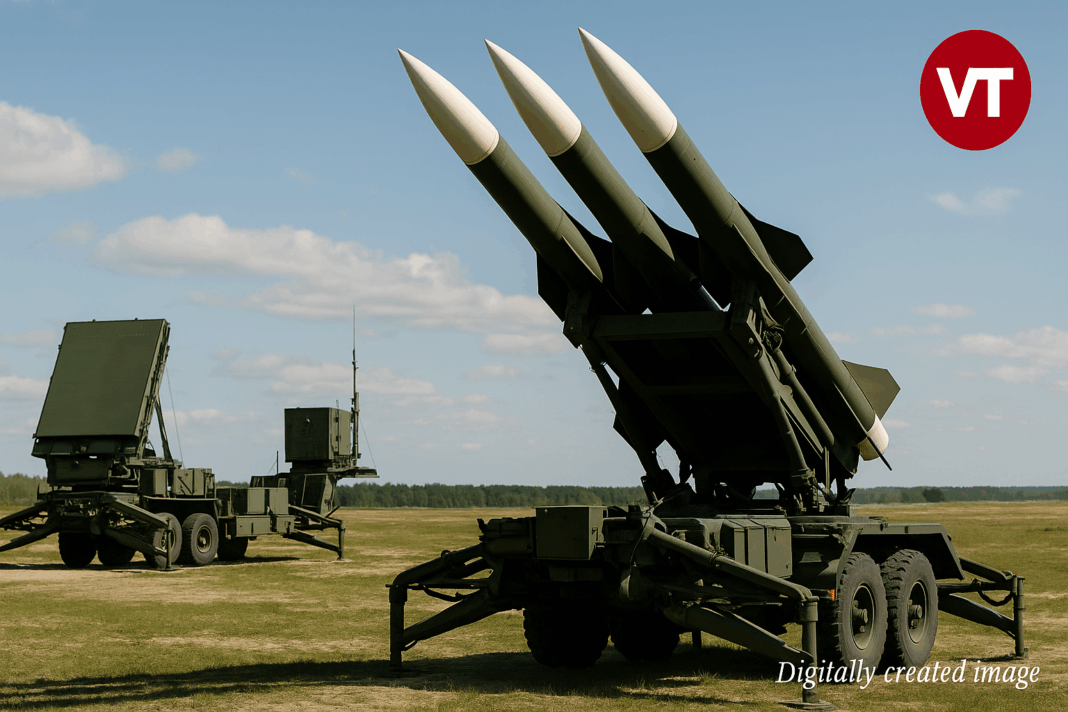• Patriot missiles are advanced U.S. air defense systems designed to intercept missiles, aircraft, and drones.
• The U.S. has provided Ukraine with Patriot batteries to defend against Russian air attacks, including hypersonic threats.
• Although powerful, the system is expensive and limited in availability, raising concerns among NATO allies about supply constraints.
Imagine you’re trying to protect your house from objects falling from the sky—maybe rocks, or even small drones. You’d need a way to spot them coming, figure out which ones are dangerous, and stop them before they hit. That’s what the Patriot missile system does, but for entire cities or military bases, and it’s built to stop things like missiles or enemy planes.
Let’s break it down simply, using verified facts from trusted sources like the U.S. Army, Raytheon Technologies, the Center for Strategic and International Studies (CSIS), and the U.S. Department of Defense.
What Are Patriot Missiles?
Think of the Patriot system like a super-smart guard dog for the sky. Its full name is the MIM-104 Patriot, which stands for “Phased Array Tracking Radar to Intercept on Target.” It was developed in the 1980s by the U.S. to defend against missiles, planes, and drones. The main components are made by Raytheon, with Lockheed Martin producing some missile parts like the PAC-3 interceptor.
The system consists of several parts working together:
- Radar: Acts like the eyes, spotting threats up to 100 km (62 miles) away.
- Control Station: The “brain” that identifies and prioritizes targets.
- Launchers: Mobile firing units that send missiles into the air.
- Missiles: The PAC-3 variant is the latest, known for its “hit-to-kill” precision—like smashing a bullet with another bullet.
According to Raytheon, the PAC-3 missile can stop targets up to 24 km (15 miles) high and 35 km (22 miles) away. It’s specifically designed to intercept fast-moving threats like ballistic missiles.
How Does the Patriot System Work?
Imagine playing a high-tech video game where you must shoot down incoming objects. That’s basically how the Patriot system operates in real life, according to the U.S. Army:
- Detection: The radar uses electronic beams to scan the sky continuously.
- Threat Analysis: Smart software classifies threats—separating enemy missiles from friendly aircraft or false targets.
- Decision-Making: Human operators or the system itself determine whether to intercept.
- Interception: The PAC-3 missile launches, using its onboard radar to home in and collide with the threat.
- Post-Launch Assessment: The system evaluates whether the threat was destroyed and adjusts its targeting algorithms accordingly.
The Patriot can track and engage multiple targets simultaneously. It also integrates well with other NATO systems, creating a broader missile shield network.
Why Is the U.S. Sending Patriots to Ukraine?
Since Russia’s invasion escalated in 2022, Ukraine has faced repeated air assaults. While it has used legacy systems like the S-300, these are less effective against modern threats such as hypersonic missiles.
In December 2022, the U.S. pledged a Patriot battery to Ukraine as part of a $1.85 billion aid package. Additional systems and support were confirmed through mid-2025, with recent posts on X citing more PAC-3 shipments and expanded deployments.
Trump Sends Patriot Missiles to Ukraine, EU to Reimburse
Here’s why this matters:
- Defense Against Advanced Missiles: Russia is using Iskander and Kinzhal missiles—some of the fastest in the world. The PAC-3 is one of the few systems capable of intercepting them, according to CSIS.
- Regional Stability: Ukraine borders NATO members like Poland. Stopping threats early helps protect the entire region.
- Strategic Signal: The U.S. demonstrates its commitment to allies and upholds deterrence against Russian aggression.
- Industrial Impact: Companies like Lockheed Martin are increasing PAC-3 production, benefiting both the economy and allied supply chains.
The Tricky Parts
Patriots are not perfect. Each PAC-3 missile costs about $4 million, according to CSIS, and batteries are limited. Training takes months, and interoperability with Ukraine’s systems can be a challenge.
Some analysts and posts on X claim the system struggles against Russia’s most advanced weapons. While there’s no verified proof of systemic failures, it’s clear that intercepting hypersonic threats is extremely difficult, even for advanced systems like the Patriot.
There’s also international tension. NATO partners like Germany and Romania have requested more Patriots, and some have raised concerns that Ukraine is being prioritized while others wait, as noted in July 2025 reports.
Wrapping It Up
The Patriot missile system is like a high-tech guard dog for the sky—spotting threats, identifying danger, and destroying them with precision missiles. While not a silver bullet, it’s one of the most reliable tools in Ukraine’s air defense against Russian aggression.
By relying on confirmed facts from trusted institutions such as the U.S. Army, Raytheon, CSIS, and the Department of Defense, and balancing claims from social media with caution, it becomes clear that Patriot systems are a vital—though limited—lifeline for Ukraine’s defense.
(with inputs from Raytheon Technologies, CSIS, Department of Defense, U.S. Army)
A global media for the latest news, entertainment, music fashion, and more.















